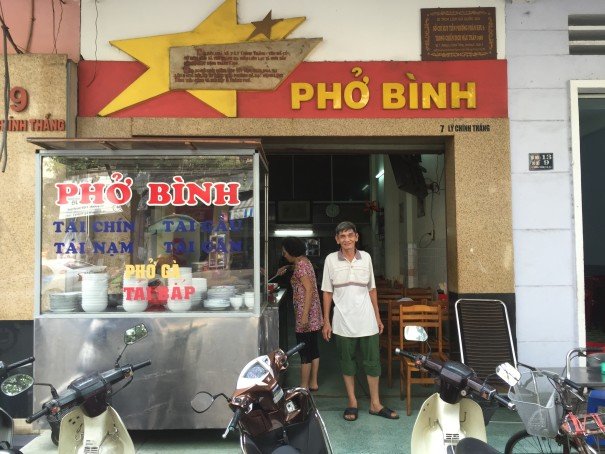
Breakfasting in the Noodle Shop Where the Tet Offensive Was Planned

Breakfasting in the Noodle Shop Where the Tet Offensive Was Planned
Pho in Saigon
The first time I ate at Pho Binh, a modest noodle shop in one of Saigon’s working-class neighborhoods, I was unaware of its ties to the Viet Cong. Back when the eatery was frequented by U.S. soldiers during the Vietnam War, there weren’t any plaques on the walls honoring Comrade Ngo Van Toai, the original owner, for his service. Other than that, Pho Binh, which ironically translates to “peace noodles,” appears much as it did during the war.
I was living down a drab little alley nearby and, out of convenience more than anything, Pho Binh became my go-to spot for a bowl of pho bo (noodle soup with beef) for breakfast. The soup is pretty much the same as you’ll find anywhere else in the city, and if you didn’t know any better, so too is the setting. It’s a family business, often with children playing with action figures at one of the tables while older relatives work a steaming vat of broth by the entrance.
Around my third or fourth time here, I noticed the plaques and photographs of Ngo Toai and asked about their significance (or rather, pointed with an inquisitive look on my face to convey interest and curiosity as best I could). That’s when Minh Nguyen, one of the family elders, led me up a dark staircase in the back to a large room with a few wooden chairs, tables, and a display case holding 25 medals. It was here, I learned, that while U.S. soldiers dined downstairs back in January 1968, a secret group of North Vietnamese, known as the City Rangers, planned one of the bloodiest attacks of the war: The Tet Offensive.
Tet is a celebration of the Lunar New Year, regarded as Vietnam’s most important holiday. Typically a time of ceasefire during the war, in 1968 the North Vietnamese saw an opportunity to bring the battle to Saigon, hoping to inspire an uprising. Until then, combat had largely remained in the countryside.
Minh was not in Saigon at the time of the seige, though he knows the family story well and, through broken English, his deliberate body language tells that this is not just a place of family pride, but national honor. A month before the strike, Ngo Toai, who operated the restaurant as a front for the North Vietnamese, was simply told to gather enough food to last 200 people for a month. As the City Rangers orchestrated the siege on strategic locations throughout the city, including the U.S. Embassy, soldiers of the 6th Subdivision of the People’s Army of Vietnam began arriving at Pho Binh under the guise that a large family was reuniting for Tet.
Though ultimately the uprising did not succeed in Saigon, the ramifications of the two violent weeks that ensued changed the scope of the conflict. The South was forced to bring reinforcements into the city, leaving the countryside vulnerable, while journalists in Saigon captured images that would permanently sway U.S. public opinion against the war. As for Ngo Toai, he was arrested soon after, tortured, and imprisoned on Con Dao Island, where he would remain until the Paris Peace Accords of 1973 and finally be recognized for his duty. Ngo passed away in 2009.
During the offensive, Minh was in Da Nang, a coastal city about 500 miles north, where shrapnel from a U.S. B52 bomber left him hospitalized for a year. Rolling up the leg of his army green pants, he shows me the scars that remain 48 years later. He then assures me with a genuine embrace, “Today, Vietnam and America are friends.”